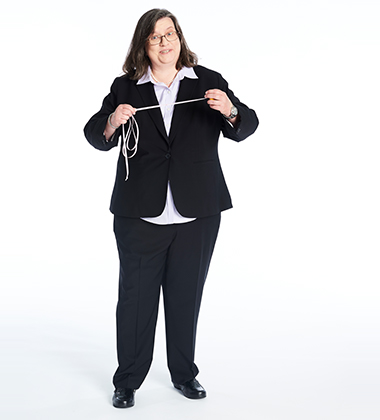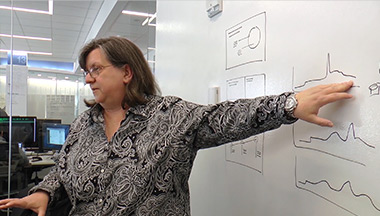Stacy Joines
- CTO, Watson Implementations
- IBM Watson
- BS Computer Science, North Carolina State University
Stacy is a pioneer in computing performance, capacity and optimization. Thank her the next time your favorite retailer’s website works perfectly on Black Friday. She’s now applying this expertise to cognitive computing and Watson.
In her own words

… on getting an early start at IBM
I’m from a small town not far from the Great Smoky Mountains National Park. It’s a beautiful place to grow up and offers a lot of liberty in its size for kids. I was in high school at the time personal computers were first hitting the market, and our school went after funding to set up a small computer lab. So I had the opportunity to take a programming class as a sophomore, and it changed all my plans for college and a career.
As I was considering where to go to college, my high school came through again with a solution. The son of one of our teachers was working as a co-op student at IBM while attending North Carolina State. That caught my attention. So when I got to NC State, I applied to the program about 15 minutes after arriving on-campus — or that’s how I remember it.
My first co-op rotation was on a test team at the IBM Cary software lab. My family was pleasantly surprised that a lifelong knack for breaking things could be put to good use to earn college funds. After three co-op rotations involving writing code, as well as breaking things, I decided writing code was a better fit for me. When IBM offered me a job in Cary full-time after graduation, I started my career on a development team.
… on taking cognitive computing out of the lab and into the hands of business
When I was with Smarter Commerce Services, my team made its reputation on delivering and sustaining large retail websites. We successfully transitioned the WebSphere Commerce portfolio from a client base of mostly small and midsize retailers to a high-volume solution for some of the largest retail web sites around the world. Large web sites generate enormous order volume and millions of dollars in revenue during their key sales periods, like Black Friday. Developing a solution to support these volumes was critical to building this client base.
This transition required a full-court press of change and refinement at the product, delivery and client level to accomplish. We even used technology from other areas of IBM not usually associated with retail, often driving changes to those products to fit the demands of high-volume websites.
So when I moved to the Watson Group, I used my knowledge of web sites, scalability and shopper behavior to develop a more representative analysis of end-user interactions with cognitive systems. This led to more nuanced metrics to describe the effectiveness of the system with real users, as well as additional techniques to keep these users engaged even when they might not formulate strong questions.
Cognitive computing requires this kind of new approach to technical delivery. It’s less about writing code, and more about training the systems to understand business and industry data. Until recently, these cognitive systems primarily lived in research organizations or very specialized applications. Today, Watson is bringing cognitive to the mainstream. Our lab services team in Watson Implementations is on the cutting edge of building and training these systems for clients, and developing best practices and assets to make these projects successful. As our experience and knowledge grows, repeating this success to many clients gets easier. It’s an exciting and interesting place to work.
… on where else Watson can go
I’m enthusiastic about where Watson is headed, and the uses our clients and others are finding for this technology. Until now, using computing meant meeting the technology on its terms — structured data and programming languages. Now, the technology is able to meet us on our terms, learning about unstructured data and working in human languages. We’ve seen only the tip of the iceberg; we can only begin to imagine how our clients will use this power to help people leverage all the data generated by the technology age.
… on what she’s reading
My reading list is a mixed bag. Recently, I read a couple of books on micro-expressions, body language, and conversation, which were good refreshers on “listening” to reactions as well as verbal responses. I usually have a mystery novel around too, or travel and historical books, like something from Simon Winchester or Nathaniel Philbrick. I also follow a daily reading program that takes me through the Bible, yearly.
